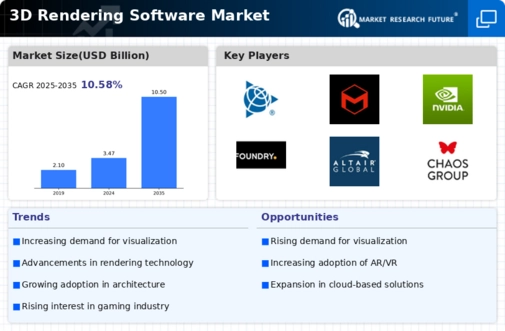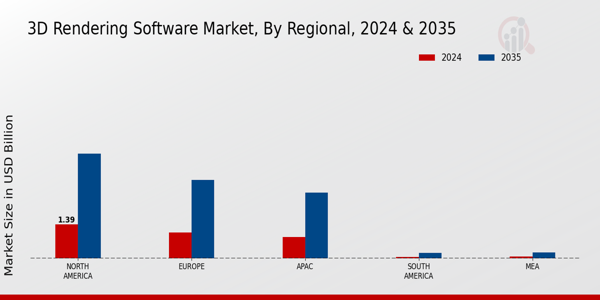Market Growth Projections
Expansion of the Gaming Industry
The expansion of the gaming industry serves as a crucial driver for the Global 3D Rendering Software Market Industry. With the continuous development of high-performance gaming consoles and PCs, there is an increasing demand for realistic graphics and immersive gameplay experiences. Game developers rely heavily on advanced rendering software to create lifelike environments and characters, which enhances player engagement. As the gaming market continues to grow, the need for sophisticated rendering solutions is expected to rise correspondingly, supporting the industry's trajectory towards a valuation of 3.47 USD Billion in 2024.
Rising Demand for Visual Content
The Global 3D Rendering Software Market Industry experiences a surge in demand for high-quality visual content across various sectors, including gaming, architecture, and film. As businesses increasingly recognize the importance of immersive experiences, the need for advanced rendering solutions becomes apparent. For instance, the architectural sector utilizes 3D rendering to create realistic visualizations, aiding in client presentations and project approvals. This trend is projected to contribute significantly to the market's growth, with the industry expected to reach 3.47 USD Billion in 2024, reflecting a robust interest in sophisticated rendering technologies.
Growing Popularity of 3D Animation in Marketing
The Global 3D Rendering Software Market Industry benefits from the increasing use of 3D animation in marketing strategies. Businesses across various sectors are adopting 3D animations to create engaging advertisements and promotional content. This trend is particularly evident in the entertainment and consumer goods industries, where visually appealing content captures audience attention more effectively. As companies recognize the potential of 3D animation to enhance brand visibility, the demand for rendering software is likely to escalate. This shift may contribute to the market's growth, aligning with the projected increase in market value to 10.5 USD Billion by 2035.
Technological Advancements in Rendering Software
Technological innovations play a pivotal role in shaping the Global 3D Rendering Software Market Industry. The introduction of real-time rendering capabilities and cloud-based solutions enhances the efficiency and accessibility of rendering processes. These advancements allow users to visualize changes instantaneously, fostering creativity and collaboration. For example, software that integrates artificial intelligence can automate complex tasks, streamlining workflows for designers and artists. As these technologies evolve, they are likely to attract more users, further propelling the market's growth trajectory towards an anticipated valuation of 10.5 USD Billion by 2035.
Increased Adoption in Virtual Reality and Augmented Reality
The integration of 3D rendering software in virtual reality (VR) and augmented reality (AR) applications significantly influences the Global 3D Rendering Software Market Industry. Industries such as real estate and education leverage these technologies to provide immersive experiences that enhance user engagement. For instance, real estate companies utilize VR to offer virtual tours of properties, allowing potential buyers to explore spaces remotely. This trend is expected to drive the market's expansion, as the demand for AR and VR applications continues to rise, potentially leading to a compound annual growth rate of 10.59% from 2025 to 2035.























